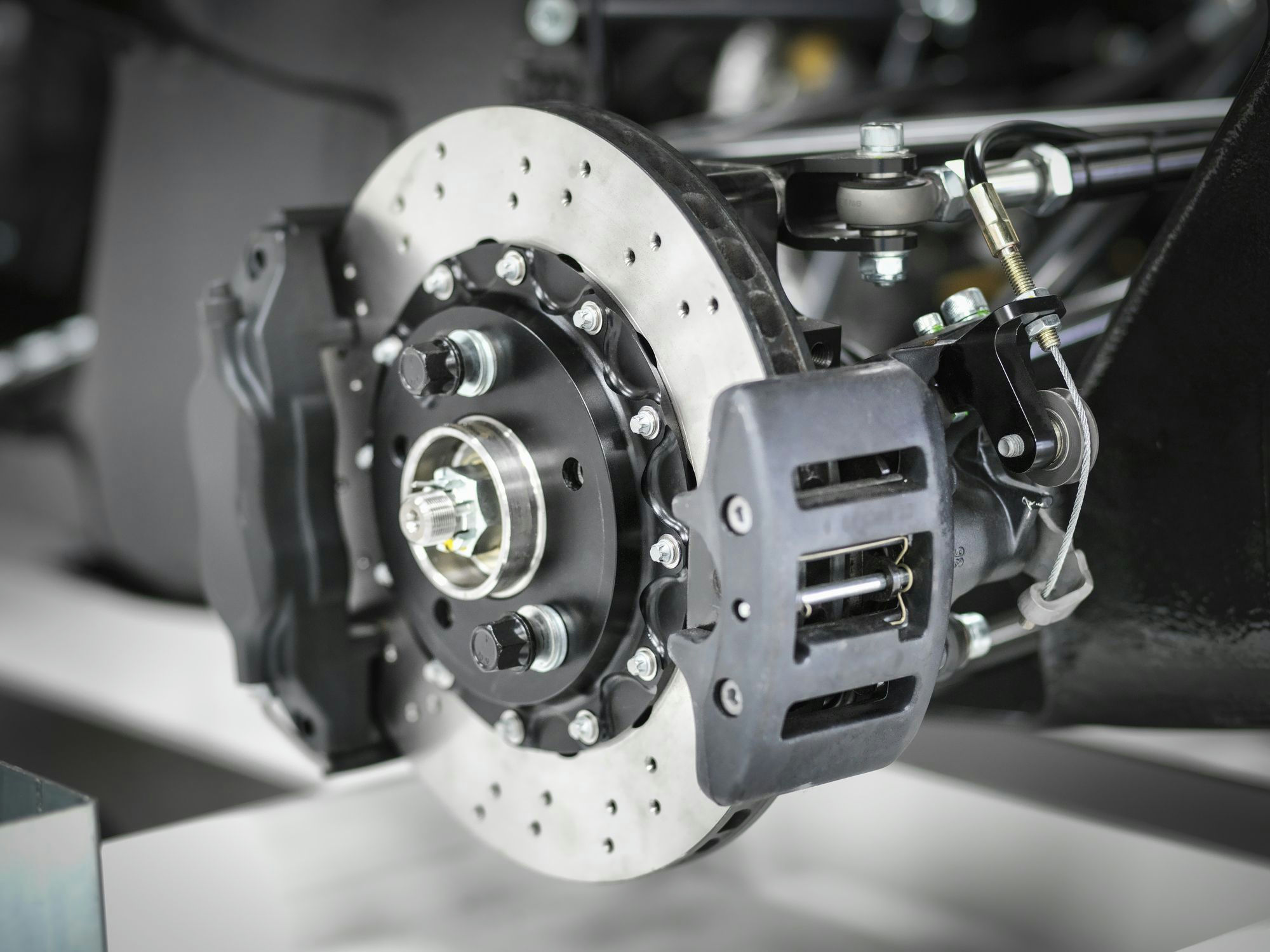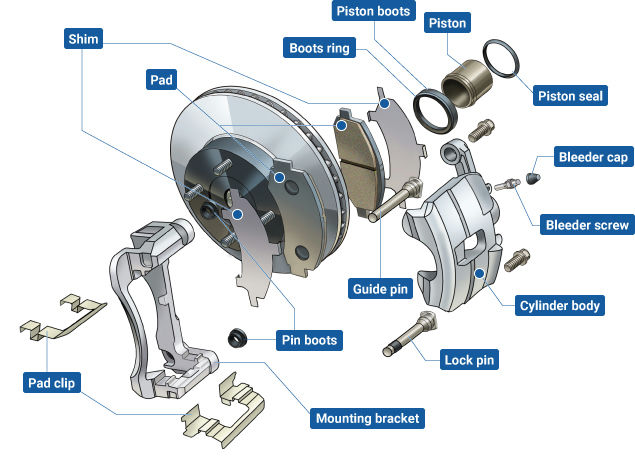
The Evolution and Functionality of Disc Brakes
Disc brakes have a rich history dating back to the early 1900s, with their widespread adoption occurring much later, around the 1950s and 1960s. Initially, drum brakes dominated the automotive scene due to their simpler and cost-effective design. However, as vehicles became faster and heavier, the limitations of drum brakes in heat dissipation and consistent stopping power became evident. Disc brakes, characterized by their use of a flat, disc-shaped rotor that spins with the wheel, emerged as a solution to these issues. They offer superior braking performance, especially in wet conditions and during high-speed driving, by utilizing brake pads that squeeze the rotor, converting kinetic energy into heat, which is then dissipated into the air. This mechanism not only ensures a more reliable and efficient braking process but also contributes to enhanced safety and driving comfort.

Improved Stopping Power
Disc brakes generally provide better stopping power than drum brakes. This means they can bring your car to a halt more quickly and efficiently. They're especially effective in wet conditions, where drum brakes can falter.
Better Heat Dissipation
Disc brakes are designed to dissipate heat more effectively. This helps prevent overheating—notorious for causing brake fade—and ensures more consistent braking performance. Good heat management is crucial for maintaining brake efficiency over time.
Lower Maintenance
Disc brakes tend to require less maintenance compared to drum brakes. They are easier to inspect and access, which simplifies routine checks and replacements. Over the long term, this can save both time and money.
More Responsive Braking
Disc brakes offer a quicker response when you press down on the brake pedal. This immediacy can improve your overall driving experience and give you a sense of control. In emergencies, every second counts, and responsive brakes can make a significant difference.
Better Performance in Wet Conditions
Disc brakes perform better in rain compared to drum brakes. Water can easily escape through the disc brake's design, reducing the chance of compromised braking. This results in safer driving in bad weather.
Less Likely to Cause Wheel Lockup
Disc brakes are less prone to causing wheel lockup than drum brakes. Modern anti-lock braking systems (ABS) work more effectively with disc brakes, contributing to safer driving. Reduced wheel lockup can minimize skidding and improve vehicle control.
Improved stopping power means that disc brakes can bring your vehicle to a halt more effectively and consistently, even under challenging conditions like wet roads. This is crucial for safety, allowing you to stop faster when needed. Comparing this to drum brakes, disc brakes maintain their performance better, providing an added layer of safety during everyday drives and emergencies alike.
In terms of heat dissipation, disc brakes have a design that helps manage and expel heat efficiently. This is important because excessive heat can lead to brake fade—where the brakes lose effectiveness. Consistent heat management ensures the brakes stay reliable and perform as expected over longer periods.
Disc brakes also boast lower maintenance requirements. They are generally easier to inspect and replace compared to drum brakes, which means routine maintenance becomes less of a hassle. While no brake system is completely maintenance-free, disc brakes simplify many of the tasks involved, potentially saving you both time and money over the life of the vehicle.
Responsiveness is another significant advantage of disc brakes. When you press the brake pedal, disc brakes react more quickly, giving you more immediate feedback and control. In critical situations, this quick response can be vital, helping you avoid accidents and navigate tricky driving conditions with more assurance.
Driving in wet conditions can be hazardous, but disc brakes offer a distinct advantage here as well. Water can escape through gaps in the disc brake's design, making them less prone to water logging compared to drum brakes. This ensures more consistent performance, keeping you safer when the roads are slick.
More Expensive to Replace
Disc brakes tend to be pricier when it comes to replacements compared to drum brakes. The higher costs come from the materials and design, which include more components. The extra expense is not just limited to the parts but also to labor, making repairs generally costlier. While they're more advanced, this can be a downside for budget-conscious drivers.
Higher Maintenance Requirements
Disc brakes are exposed to the elements, meaning they are more prone to wear and tear. This typically translates into more frequent maintenance. Drivers need to periodically change pads and check for rotor warp. Though they offer better braking performance, they demand more attention.
Noise Issues
Disc brakes can sometimes be noisy, especially when they are cold or wet. The sound can be unsettling for some drivers, leading to concerns even when everything is functioning correctly. While noise doesn’t always indicate a problem, it can be annoying. Proper lubrication and maintenance can mitigate this issue but not always eliminate it.
Not as Effective When Cold
Disc brakes may not perform optimally when they're cold. This is especially noticeable during early morning drives or in colder climates. Drivers might experience a slight delay in stopping power until the brakes warm up. It’s a minor inconvenience but can be important in certain driving conditions.
Susceptible to Warping
The thin rotors in disc brakes can warp under extreme heat or stress. This can lead to vibrations and reduced braking efficiency. Warping generally means the rotors will need to be replaced, adding to maintenance costs. It's not a frequent issue, but it does happen, particularly in high-performance situations.

Disc brakes are a commonplace technology in the automotive industry. They offer reliable performance and consistent stopping power, making them a favored choice for various vehicle types. Let's examine a few specific car models where disc brakes are utilized effectively to provide the kind of braking performance that drivers expect.
Honda Civic
The Honda Civic is one example where disc brakes come standard. This compact car, well-known for its fuel efficiency and reliability, uses disc brakes to ensure smooth and reliable stopping. The front discs are ventilated, which means they have slots or holes to help dissipate heat. This is particularly beneficial for a car like the Civic, frequently driven in urban environments where stop-and-go traffic can cause brakes to overheat.
Ford F-150
Similarly, the Ford F-150, a widely popular pickup truck, uses disc brakes. Given the truck’s capability for towing and heavy hauling, the braking system needs to be robust. The F-150 typically features larger discs in both the front and rear to handle the increased load and provide enough braking force to manage heavy weights safely. This ensures that the truck maintains its stopping power even when it's fully loaded or towing.
Mercedes-Benz E-Class
Turning our attention to the luxury segment, the Mercedes-Benz E-Class sedan combines performance with comfort. The E-Class employs disc brakes with advanced features like electronic stability control and anti-lock braking systems (ABS) for optimal performance. These components work in tandem to provide a responsive and controlled braking experience, which is essential for the high-speed stability and comfort expected from a luxury sedan.
Chevrolet Camaro
On the sportier side of things, the Chevrolet Camaro is a muscle car that relies heavily on its braking system. High-performance models like the Camaro often have larger ventilated disc brakes to cope with the high speeds and aggressive driving styles typical of sports cars. The braking system ensures that drivers have the confidence to take on challenging driving scenarios, whether on a track or winding road.
Toyota RAV4
The Toyota RAV4, a popular compact SUV, uses disc brakes as well. Given its role as a family vehicle, safety is paramount. The disc brakes provide good stopping power needed for city driving, highway cruising, and the occasional off-road adventure. The discs on the RAV4 are generally designed to handle diverse driving conditions, providing a balanced mix of durability and performance.
In conclusion, disc brakes are found across various types of vehicles from compact cars like the Honda Civic to luxury sedans such as the Mercedes-Benz E-Class, robust trucks like the Ford F-150, high-performance sports cars like the Chevrolet Camaro, and practical SUVs such as the Toyota RAV4. Their application in these diverse vehicles highlights their adaptability and crucial role in delivering consistent and reliable braking performance.
That's just over the last decade according to the night Franks Luxury Investment Index, making it the best-performing asset class of any other type of collectible. MyGarage.AI was developed to take your car collection and preservation the extra mile with a growing list of innovative features.
Utilize cutting-edge AI to discover fascinating facts about your car and compose engaging, descriptive narratives that highlight its unique story.

Access vast datasets to populate your car’s specifications, title history, and more, ensuring your records are detailed and accurate.

Document key aspects of your car’s history, maintenance, restoration, customization, and performance. Preserve every detail that makes your car special.

Store photos, videos, and records of awards or special recognition, creating a rich, visual history of your vehicle.

Join group forums and participate in event postings to connect with fellow car enthusiasts and build a supportive community.

Enjoy complete control over your privacy and sharing settings. Share your car’s legacy through a searchable gallery or on social media platforms with ease.

Our mobile-friendly platform makes it easy to document and share your car’s legacy anytime, anywhere.

Discover, preserve, and share the legacy of your precious automotive assets to increase their appeal and value.